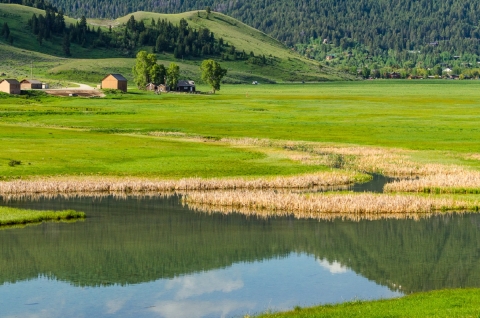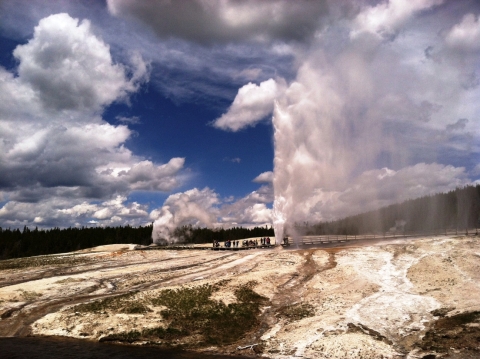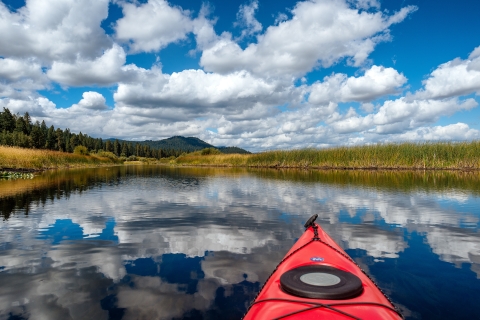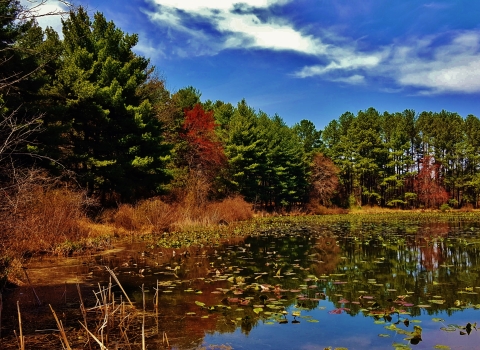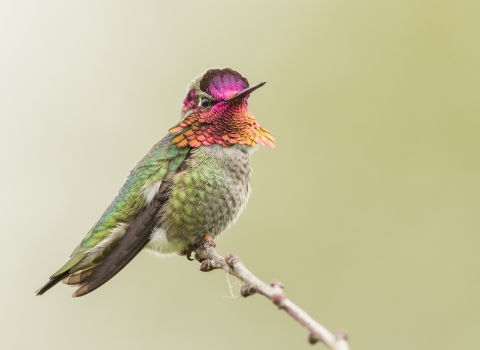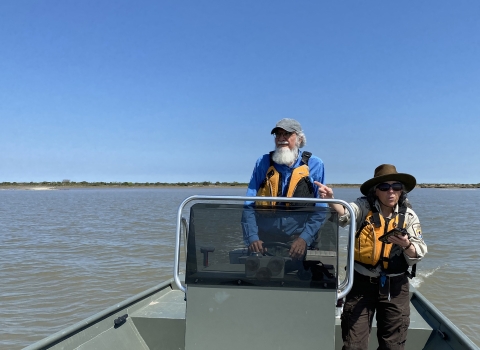Millions of Americans visit national parks and national seashores each year. They see iconic landscapes, sweeping vistas and – sometimes – crowds. If you’re looking for a quieter experience off the beaten path, try a nearby national wildlife refuge national wildlife refuge
A national wildlife refuge is typically a contiguous area of land and water managed by the U.S. Fish and Wildlife Service for the conservation and, where appropriate, restoration of fish, wildlife and plant resources and their habitats for the benefit of present and future generations of Americans.
Learn more about national wildlife refuge , too.
This story highlights several refuges worth a stop if you’re at neighboring national parks. As you consider the National Wildlife Refuge System-National Park Service pairs below, please remember three things:
- Because national wildlife refuges exist primarily to conserve wildlife, visitors must tread softly. For instance, camping is not allowed at most refuges in the lower 48 states, but walking on pleasant trails almost always is.
- Dawn and dusk are the best times of day to see wildlife at most wildlife refuges.
- Time of year will influence what you see because birds, fish and other wildlife move and behave seasonally. Spring and fall migration periods are particularly good times to see birds at wildlife refuges.
San Luis National Wildlife Refuge/ Yosemite National Park
San Luis National Wildlife Refuge is 115 miles west of Yosemite National Park. If you visit the refuge between late July and late September, you might see – or hear – male tule elk bugling during the annual rut. An auto tour route and eight nature trails offer a chance to see elk, black-tailed deer, coyotes, river otters, rabbits, raptors, shorebirds, wading birds and songbirds.
Tip from San Luis Refuge outdoor recreation planner Jack Sparks: “To beat the heat, wildlife is most active around dawn and dusk, which is when visitors can most likely observe them.”
National Elk Refuge/ Yellowstone National Park
National Elk Refuge is 60 miles south of Yellowstone National Park and eight miles south of Grand Teton National Park.
Summer is a wonderful time to visit the refuge and its historic Miller Ranch, located at the foot of the Gros Ventre Mountains, with a commanding view of the Tetons. For more than a century, the ranch has figured in the settlement of the Jackson Hole Valley, and the area’s interest in ranching and conservation. The ranch is open from late May through mid-September.
In summer, says former refuge outdoor recreation planner Lori Iverson, “marsh edges attract songbirds, while open ponds and meadows support ducks, geese, trumpeter swans and sandhill cranes. The refuge’s wintering elk have moved to mountain meadows and forests, which offer abundant food and escape from the warmer temperatures. However, an occasional moose or pronghorn can be spotted.”
Tip from Iverson: If you visit in winter, take a sleigh ride to get a close-up view of the elk and learn how they survive.
J.N. "Ding" Darling National Wildlife Refuge/ Everglades National Park
J.N. “Ding” Darling National Wildlife Refuge is 85 miles northwest of Everglades National Park’s Gulf Coast Visitor Center.
The refuge is best known for winter birding. In summer, manatees can be found in Tarpon Bay. Alligators are often visible at dawn and dusk. And sea turtle hatchlings start to emerge from nests in August. The refuge offers free family-friendly education programs through early August. Kids might enjoy the Indigo Trail Wildlife Education Boardwalk, where they can learn to identify animal scat and Get the Scoop on Wildlife Poop (video).
Upper Klamath National Wildlife Refuge/ Crater Lake National Park
Upper Klamath National Wildlife Refuge and Crater Lake National Park are 25 miles apart on the Volcanic Legacy Scenic Byway. Rocky Point, a rustic Oregon lodge with a marina, is the gateway to the refuge.
Tip from refuge ranger Steve Rooker: “Early morning or late-afternoon canoe trips are perfect during hot summer months. Visitors can rent a canoe at the marina and paddle directly into the refuge wetland area. An 8.5-mile canoe trail leads through a maze of tule reeds and cattails.” On average, visitors spend about three hours canoeing the refuge.
Along the trail, visitors may see wading birds, waterfowl, otters and beavers. Both the park and the refuge can be enjoyed in a full 12-hour day.
Rocky Mountain Arsenal National Wildlife Refuge/ Rocky Mountain National Park
Rocky Mountain Arsenal National Wildlife Refuge is 70 miles from Rocky Mountain National Park.
During summer months at the refuge “colorful wildflowers are in full bloom across the prairie grasses. Burrowing owls are nesting in prairie dog burrows. White-tailed and mule deer fawns have white-spotted coats. Cinnamon-colored bison calves can be seen in the bison herd. And songbirds are nesting in prairie grasses,” says former refuge ranger Cindy Souders. “White pelicans, American coots, cormorants and others can be found in refuge lakes. Painted turtles and dragonflies can be seen in wetland areas.”
Not bad for a prairie landscape 13 miles northeast of downtown Denver. With a dozen walking trails and an 11-mile auto tour route, Rocky Mountain Arsenal Refuge is well worth an early morning or evening visit.
Billy Frank Jr. Nisqually National Wildlife Refuge/ Olympic National Park
Billy Frank Jr. Nisqually National Wildlife Refuge is 125 miles from Olympic National Park headquarters.
“The refuge has much more variety of habitat in a smaller area than Olympic or Mount Rainier Park, and it’s right off I-5,” says former refuge visitor services assistant Peter Yager. “For people who want to take a short morning or afternoon walk and see a variety of birds and other animals, the refuge is ideal.”
The refuge’s Estuary Boardwalk Trail and connecting Twin Barns Loop make a scenic four-mile loop through freshwater wetlands, tidal flats and forest with views of the Nisqually River and Puget Sound. In summer, you're likely to see wood ducks and beavers in the wetlands and Caspian terns and harbor seals in the saltwater estuary. Swallows, American goldfinches, warblers, herons and bald eagles are common.
Tips from Yager: “Early morning is the best time to see and hear songbirds. Wildlife viewing on the estuary is best right after high tide.”
Merritt Island National Wildlife Refuge/ Canaveral National Seashore
Merritt Island National Wildlife Refuge is co-managed with Canaveral National Seashore.
“Summer is one of the best times to see manatees,” says refuge visitor services manager Kim King-Wrenn. “The refuge has an observation deck that overlooks the Haulover Canal, which is a reliable place to spot manatees. What’s great about manatees is that you can see them just about any time of day all summer long. You can also sign up to go on a ranger-guided sea turtle program. These are offered at night to observe the loggerhead sea turtles nesting on the beach. They are presented in cooperation with the National Park Service. You sign up with Canaveral National Seashore, and then you meet at the refuge visitor center.”
And you can kayak on one of the lagoons after dark and enjoy the spectacle of bioluminescent algae. The algae glow especially brightly because there is very little light pollution. “You can see the algae glow any night in June, July or August,” King-Wrenn says, “but the dark of the new moon is best.”
The refuge has seven walking trails, including a short wheelchair-accessible boardwalk trail.
Okefenokee National Wildlife Refuge/ Cumberland Island National Seashore
Okefenokee National Wildlife Refuge is 40 miles west of Cumberland Island National Seashore.
The refuge, at the headwaters of the Suwannee and St. Marys Rivers, offers recreational opportunities from wildlife viewing (alligators, birds, tortoises and snakes) to canoeing to fishing and hunting.
Okefenokee Adventures, at the refuge’s east entrance, provides guided boat tours and canoe/kayak/boat rental.
Chincoteague National Wildlife Refuge/ Assateague Island National Seashore
Assateague Island is a barrier island straddling the Maryland-Virginia border in the Atlantic Ocean. There you’ll find Chincoteague National Wildlife Refuge, just south of Assateague Island National Seashore. Located on the same island, the two sites have similar habitats but slightly different recreational priorities.
The seashore, on the Maryland side of Assateague Island, offers camping and allows pets. The seashore’s educational and interpretive programs focus on the fascinating historical and natural significance of the ocean and bay.
On the Virginia part of the island, the refuge closes overnight and does not permit camping or pets. However, it does host stunning forest and wetland ecosystems that lend themselves to year-round birdwatching and wildlife photography. Visitors also enjoy miles of walking/biking trails. A must-see is the historic Assateague Lighthouse, which refuge ranger Aubrey Kurtz calls “a cultural treasure.” Crabbing, clamming and fishing also are popular. Universal perks of Assateague Island are the serenity of moments on the beach and the majesty of seeing the world-famous ponies.
Ash Meadows National Wildlife Refuge/ Death Valley National Park
Ash Meadows National Wildlife Refuge is 48 miles east of Death Valley National Park.
“We have a great new visitor center that is open seven days a week where guests can escape the heat, learn about the refuge, shop in our bookstore and watch a video about the refuge,” says former visitor center manager Adrienne McGill. The refuge is the largest oasis in the Mojave Desert. Many of the refuge’s rare and endemic plants are lush, green and in bloom in summer. For those properly prepared for the 100-plus-degree heat, several boardwalks traverse various habitats, where you can see birds, reptiles and the rare and endangered Ash Meadows Amargosa pupfish.
The refuge also features Devils Hole, which has the world’s only wild population of endangered Devils Hole pupfish. Devils Hole, technically a part of Death Valley National Park, is a water-filled cavern whose bottom has never been mapped. “Although it is difficult to see the fish from the viewing platform,” says McGill, “many guests still like to visit Devils Hole and are fascinated by the fish as well as the mystery of our not knowing how deep it goes.”
Kenai National Wildlife Refuge/ Kenai Fjords National Park
Kenai National Wildlife Refuge headquarters is 95 miles from Kenai Fjords National Park headquarters.
“Kenai Refuge comes alive in the summer,” says refuge ranger Leah Eskelin. “Every acre is amazing. Every habitat is full of life – from the alpine tundra to the boreal forest and, of course, the world-famous Kenai River.” Most visitors gravitate to the river, she says. “Anglers love it for the salmon and trout fishing. Solitude-seekers love the riverside camping spots along the Upper Kenai River. Hikers love to take the numerous trails to the river banks and mountain vistas overlooking its turquoise waters. Photographers love to spot bears ambling along the river’s gravel bars.”
Refuge wildlife is diverse. You might catch a glimpse of moose, caribou, black and brown bears, lynx, trumpeter swans, bald eagles, beaver or spruce grouse.
Tip from Eskelin: “Many Alaskan animals are crepuscular, meaning they are most active just before dawn and after twilight. That doesn't mean much when there are 19 hours of daylight, as there are here in June. So, simply, it’s best to look for wildlife early in the morning before breakfast or late at night after dinner.”
Pea Island National Wildlife Refuge/ Cape Hatteras National Seashore
Pea Island National Wildlife Refuge is next door to Cape Hatteras National Seashore on the Outer Banks of North Carolina. Alligator River National Wildlife Refuge is nearby. Both refuges offer a range of wildlife-oriented recreational opportunities, from paddling and walking to fishing and hunting.
The Coastal North Carolina Gateway National Wildlife Refuges Visitor Center in Manteo on Roanoke Island is great place to learn about these two refuges and seven others not far away.
Happy vacationing!




